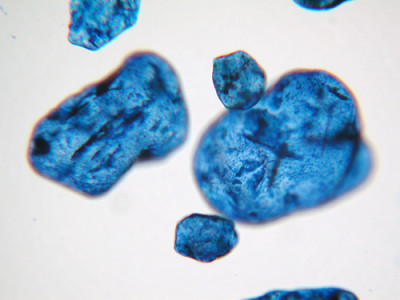Minerals
Depending on the the amount of sample, the properties of the sample, and ultimately, the goal of analysis, mineral characterization can be approached from a variety of analytical methods. In many cases, stereomicroscopy and polarized light microscopy are sufficient. Raman microspectroscopy has recently become an extremely useful tool for the identification of minerals and the characterization of specific properties. Transmission electron microscopy and x-ray diffraction become useful when studying small particles, bulk mixtures, or asbestos.
Identification
The identification of minerals, which may include light minerals such as quartz and feldspars, clay minerals like talc and kaolin, asbestiform minerals such as chrysotile and tremolite, or heavy minerals such as zircon and tourmaline, is relatively straightforward. Recognition and classification of biogenic particles such as forams, diatoms, pollen, and plant crystals (opal phytoliths) can also provide useful information about the content of dust or the source of particles.
Advanced polarized light microscopy can be used to characterize specific optical (e.g., refractive index, birefringence, or optic sign) or morphological properties or to compare varieties of the same mineral (such as hornblende varieties). Other methods including Raman spectroscopy and trace element techniques such as micro-XRF can provide other types of information Microtrace scientists have developed internal Raman spectral databases and have conducted research into the properties of minerals using a combination of the above methods. For example, a Microtrace scientist studied the degree of metamictization in zones within zircon a crystal to correlate uranium and thorium content with the amorphization of the crystal structure.
Forensic Comparison
Microtrace scientists have contributed greatly to the recognized approach for the highest level of forensic soil comparisons, which often center around mineral identification. This has resulted in the publication of several texts on this topic as well as Microtrace’s participation in two major forensic working groups (one national, the other international) tasked with systematizing forensic soil analyses.
Geosourcing
In many forensic and intelligence investigations, comparison samples are not available. In these cases, it is often beneficial to examine the fundamental components of a sample with the goal of learning as much about a location or activity as possible. In these instances, minerals can provide crucial information about the geographic environment from which a sample originated. Microtrace has pioneered these types of investigations, known as geosourcing or forensic geolocation, and has played a major role in investigations ranging from the uncovering of major theft rings to determining the locations where particular crimes occurred.
Synthetic Minerals
Synthetic or anthropogenically modified materials range from valuable gemstones to commodities such as inorganic pigments and fillers. Characterization can provide information about the identity of such materials, but often focuses upon specific properties such as particle size, fluorescence, trace element content, or optical properties.
How May We Help You?
Contact usto discuss your project in more detail.








